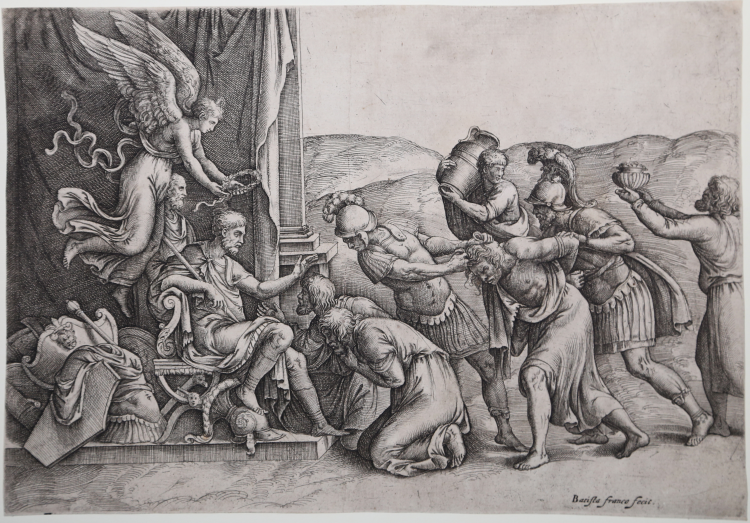




| Reference: | S39830 |
| Author | Giovanni Battista FRANCO |
| Year: | 1540 ca. |
| Measures: | 375 x 261 mm |



| Reference: | S39830 |
| Author | Giovanni Battista FRANCO |
| Year: | 1540 ca. |
| Measures: | 375 x 261 mm |
Etching and engraving, signed at lower right “Batista franco fecit”. After Giulio Romano.
Second state of two, with the signature at lower right.
A very good impression, printed with tone on contemporary laid paper, trimmed to the platemark, trace of light vertical paper fold, very good condition.
Reproduces the fresco in a medalion in the Sala dei Venti, Palazzo del Te, Mantua, executed after Giulio's design probably by Girolamo da Pontremoli or Agostino di Mozzanega. Giulio's related drawing is in the Louvre, inv. no. 3728, and another one, once in the Ellesmere Collection, was sold at Sotheby's London in 1972. There is another related drawing in the Albertina, Vienna, previously attributed to Battista Franco, today registered as Venetian School, inv. no. 149. The print differs from the fresco in the inclusion of the eighth figure holding the vase, and the substitution of the brick building with a curtain.
|
Bartsch XVI.136.54; Le Blanc II.250.12; Dillon in Venice 1981, no. 147; Giulio Romano, n. 181; TIB.32.210.54-II.
|
Giovanni Battista FRANCO (Udine 1510 – Venezia 1580)
|
Battista Franco dei Franchi, also known as Semoleo or Semolei, was engraver, drawer, painter and etcher; he was born and he died in Venice, as recorded on official documents.
Franco worked in Rome, Florence and Urbino, where he met and started loving Italian Mannerism. While in Rome, he engraved many subjects from Michelangelo, his favourite artist; according to Vasari, he also engraved a magnificent Giudizio Universale.
For sure Franco knew the frescoes of the Vatican, for in many prints we can see the influence of paintings such as Giulio Romano’s Donazione di Costantino. Romano was a real source of inspiration for Franco, for both in Rome and Mantua he worked on his subjects, as it can be seen in the frescoes of the Tè.
In 1552 he went back to Venice, where he lived till his death; he worked for the Libreria Marciana (1556) and on the vault of the Golden Staircase in the Palazzo Ducale, before starting the decoration of Villa Foscari. In the decoration of the Villa is once again clear the influence of Michelangelo. He engraved and signed about 100 plates, with the monogram, BF or BFVF (Battista Franco venetiano fecit), whose style is very close to that of Giulio Bonasone.
Bartsch lists 93 engravings of this artist, Passavant 98.
|
|
Bartsch XVI.136.54; Le Blanc II.250.12; Dillon in Venice 1981, no. 147; Giulio Romano, n. 181; TIB.32.210.54-II.
|
Giovanni Battista FRANCO (Udine 1510 – Venezia 1580)
|
Battista Franco dei Franchi, also known as Semoleo or Semolei, was engraver, drawer, painter and etcher; he was born and he died in Venice, as recorded on official documents.
Franco worked in Rome, Florence and Urbino, where he met and started loving Italian Mannerism. While in Rome, he engraved many subjects from Michelangelo, his favourite artist; according to Vasari, he also engraved a magnificent Giudizio Universale.
For sure Franco knew the frescoes of the Vatican, for in many prints we can see the influence of paintings such as Giulio Romano’s Donazione di Costantino. Romano was a real source of inspiration for Franco, for both in Rome and Mantua he worked on his subjects, as it can be seen in the frescoes of the Tè.
In 1552 he went back to Venice, where he lived till his death; he worked for the Libreria Marciana (1556) and on the vault of the Golden Staircase in the Palazzo Ducale, before starting the decoration of Villa Foscari. In the decoration of the Villa is once again clear the influence of Michelangelo. He engraved and signed about 100 plates, with the monogram, BF or BFVF (Battista Franco venetiano fecit), whose style is very close to that of Giulio Bonasone.
Bartsch lists 93 engravings of this artist, Passavant 98.
|